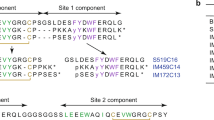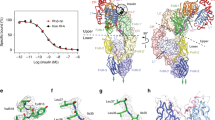Abstract
Insulin receptors are composed of two 130-kDa α subunits and two 90-kDa β subunits which are linked by disulfide bonds forming a heterotetrameric structure (see reviews by Czech1, and Goldfine2). The two subunits are synthesized as a single-chain precursor protein encoded by 22 exons3. The α subunit, extracellularly located, is anchored to the cell membrane by disulfides to the β subunit which contains a putative trans-membrane domain4. Photoaffinity labeling with light-sensitive insulin photoprobes5 and chemical crosslinking6 have established that insulin binds to the extracellular α subunit. Insulin binding causes the autophosphorylation of the insulin receptor β subunit, the latent tyrosine kinase activity of which is thus stimulated as a consequence. The activation of insulin receptor kinase activity initiates a cascade of intra-cellular protein phosphorylation which regulates the cellular metabolic and mitogenic activity in response to insulin (see reviews by Goldfine2 and by Rosen7). Studies of the effect on the cellular response to insulin in mutant receptors in which the intracellular β subunit has been modified by site-mutagenesis or sequence deletion have demonstrated the domain related multifunctional nature of the insulin receptor (see review by Olefsky8).
Access this chapter
Tax calculation will be finalised at checkout
Purchases are for personal use only
Preview
Unable to display preview. Download preview PDF.
Similar content being viewed by others
References
M.P. Czech, The nature and regulation of the insulin receptor: Structure and function, Annu. Rev. Physiol. 47:357 (1985).
I.D. Goldfine, The insulin receptor: Molecular biology and transmembrane signaling, Endocr. Rev. 8:235 (1990).
S. Seino, M. Seino, S. Nishi, and G.I. Bell, Structure of the human insulin receptor gene and characterization of its promoter, Proc. Natl. Acad. Sci. U.S.A. 86:114 (1989).
A. Ullrich, J.R. Bell, E.Y. Chen, R. Herrera, L.M. Petruzzelli, J.T. Dull, A. Grey, L. Coussens, Y.-C. Liao, M. Tsubokawa, M. Mason, P.H. Seeburg, C. Grunfeld, O.M. Rosen, and J. Ramachandra, Human insulin receptor and its relationship to the tyrosine kinase family of oncogenes, Nature 313:756 (1985).
C.C. Yip, C.W.T. Yeung, and M.L. Moule, Photoaffinity labeling of insulin receptor proteins of liver plasma membrane preparations, Biochem. 19:70 (1980).
P.F. Pilch, and M.P. Czech, The subunit structure of the high affinity insulin receptor, J. Biol. Chem. 255:1722 (1980).
O.M. Rosen, After insulin binds, Science 237:1452 (1987).
J.M. Olefsky, The insulin receptor: A multifunctional protein, Diabetes 39:1009 (1990).
X.J. Sun, P. Rothenberg, C.R. Kahn, J.M. Backer, E. Araki, P.A. Wilden, D.A. Cahill, B.J. Goldstein, and M.F. White, Structure of the insulin receptor substrate 1RS-1 defines a unique signal transduction protein, Nature 342:73 (1991).
C.C. Yip, C.W.T. Yeung, and M.L. Moule, Photoaffinity labelling of insulin receptor of rat adipocyte plasma membrane, J. Biol. Chem. 253:1743 (1978).
C.C. Yip, H. Hsu, R.G. Patel, D.M. Hawley, B.A. Maddux, and I.D. Goldfine, Localization of the insulin-binding site to the cysteinerich region of the insulin receptor α-subunit, Biochem. Biophys. Res. Commun. 157:321 (1988).
C.C. Yip, C. Grunfeld, and I.D. Goldfine, Identification and characterization of the ligand-binding domain of the insulin receptor: Insulin-induced conformational changes demonstrated by the use of an anti-peptide antiserum against the amino acid sequence 242–251 of the alpha subunit, Biochem. 30:695 (1991).
R.G. Mirmira, S.H. Nakagawa, and H.S. Tager, Importance of the character and configuration of residues B24, B25, and B26 in insulin-receptor interactions, J. Biol. Chem. 266:1428 (1991).
R. Rafaeloff, R. Patel, C.C. Yip, I.D. Goldfine, and D.M. Hawley, Mutation of the high cysteine region of the human insulin receptor α-subunit increases insulin receptor binding affinity and transmembrane signalling, J. Biol. Chem. 264:15900 (1989).
T.A. Gustafson, and W.J. Rutter, The cysteine-rich domains of the insulin and insulin-like growth factor I receptors are primary determinants of hormone binding specificity: Evidence from receptor chimeras, J. Biol. Chem. 265:18663 (1990).
A.S. Andersen, T. Kjeldsen, F.C. Wiberg, P.M. Christensen, J.S. Rasmussen, K. Noms, K.B. Moller, and N.P.H. Moller, Changing the insulin receptor to possess insulin-like growth factor I ligand specificity, Biochem. 29:7363 (1990).
T. Kjeldsen, A.S. Andersen, F.C. Wiberg, J.S. Rasmussen, L. Schaffer, P. Baischmidt, K.B. Moller, and N.P.H. Moller, The ligand specificities of the insulin receptor and the insulin-like growth factor I receptor reside in different regions of a common binding site, Proc. Natl. Acad. Sci. U.S.A. 88:4404 (1991).
B. Zhang, and R.A. Roth, Binding properties of chimeric insulin receptors containing the cysteine-rich domain of either the insulin-like growth factor I receptor or the insulin receptor related receptor, Biochem. 30:5113 (1991).
C.C. Yip, The insulin-binding domain of insulin receptor is encoded by exon 2 and exon 3, J. Cell. Biochem. 48:19 (1992).
C.K. Chou, T.J. Dull, D.S. Russell, R. Gherzi, D. Lebwohl, A. Ullrich, and O.M. Rosen, Human insulin receptors mutated at the ATP-binding site lack protein tyrosine kinase activity and fail to mediate postreceptor effects of insulin, J. Biol. Chem. 262:1842 (1987).
H.E. Tornqvist, M.W. Pierce, A.R. Frackelton, R.A. Nemenoff, and J. Avruch, Identification of insulin receptor tyrosine residues autophosphorylated in vitro, J. Biol. Chem. 262:10212 (1987).
M.F. White, S.E. Shoelson, H. Keutmann, and C.R. Kahn, A cascade of tyrosine autophosphorylation in the ß-subunit activates the phosphotransferase of the insulin receptor, J. Biol. Chem. 262:2969 (1987).
M.A. Shia, J.R. Rubin, and P.F. Pilch, The insulin receptor protein kinase: Physicochemical requirements for activity, J. Biol. Chem. 263:6822 (1988).
L.M. Petruzzelli, R. Herrera, and O.M. Rosen, Insulin receptor is an insulin-dependent tyrosine protein kinase: Copurification of insulin-binding activity and protein kinase activity to homogeneity from human placenta, Proc. Natl. Acad. Sci. U.S.A. 81:3327 (1984).
Y. Fujita-Yamaguchi, and S. Kathuria, The monomeric αβ form of the insulin receptor exhibits much higher insulin-dependent tyrosine-specific protein kinase activity than the intact α2β2 form of the receptor, Proc. Natl. Acad. Sci. U.S.A. 82:6095 (1985).
L.J. Sweet, P.A. Wilden, and J.E. Pessin, Dithiothreitol activation of the insulin receptor/kinase does not involve subunit dissociation of the native α2β2 insulin receptor subunit complex, Biochem. 25:7068 (1986).
L.J. Pike, A.T. Eakes, and E.G. Krebs, Characterization of affinity-purified insulin receptor/kinase: Effects of dithiothreitol on receptor/kinase function, J. Biol. Chem. 261:3782 (1986).
L.J. Pike, E.A. Kuenzel, J.E. Casnellie, and E.G. Krebs, A comparison of the insulin-and epidermal growth factor-stimulated protein kinases from human placenta, J. Biol. Chem. 259:9913 (1984).
P.A. Wilden, and J.E. Pessin, Differential sensitivity of the insulin-receptor kinase to thiol and oxidizing agents in the absence and presence of insulin, Biochem. J. 245:325 (1987).
C. Li, M.L. Moule, and C.C. Yip, Insulin receptors prepared with iodoacetamide show enhanced autophosphorylation and receptor kinase activity, J. Biol. Chem. 266:7051 (1991).
S. Tamura, Y. Fujita-Yamaguchi, and J. Larner, Insulin-like effect of trypsin on the phosphorylation of rat adipocyte insulin receptor, J. Biol. Chem. 258:14749 (1983).
L. Ellis, D.O. Morgan, E. Clauser, R.A. Roth, and W.J. Rutter, A membrane-anchored cytoplasmic domain of the human insulin receptor mediates a constitutively elevated insulin-independent uptake of 2-deoxyglucose, Mol. Endocrinol. 1:15 (1987).
H. Gilbert, Redox control of enzyme activities by thiol/disulfide exchange, Methods Enzymo. 107:330 (1984).
F.M. Finn, K.D., Ridge, and K. Hofmann, Labile disulfide bonds in human placental insulin receptor, Proc. Natl. Acad. Sci. U.S.A. 87:419 (1990).
C.C. Yip, and E. Jack, Insulin receptors are bivalent as demonstrated by photoaffinity labeling, J. Biol. Chem. 267:13131 (1992).
A.E. Zimmerman, M.L. Moule, and C.C. Yip, Guinea pig insulin: II. Biological activity, J. Biol. Chem. 249:4026 (1974).
A.R. Bauskin, I. Alkalay, and Y. Ben-Neriah, Redox regulation of a protein tyrosine kinase in the endoplasmic reticulum, Cell 66:685 (1991).
Author information
Authors and Affiliations
Editor information
Editors and Affiliations
Rights and permissions
Copyright information
© 1993 Springer Science+Business Media New York
About this chapter
Cite this chapter
Yip, C.C. (1993). Insulin Receptor: Aspects of its Structure and Function. In: Östenson, C.G., Efendić, S., Vranic, M. (eds) New Concepts in the Pathogenesis of NIDDM. Advances in Experimental Medicine and Biology, vol 334. Springer, Boston, MA. https://doi.org/10.1007/978-1-4615-2910-1_6
Download citation
DOI: https://doi.org/10.1007/978-1-4615-2910-1_6
Publisher Name: Springer, Boston, MA
Print ISBN: 978-1-4613-6262-3
Online ISBN: 978-1-4615-2910-1
eBook Packages: Springer Book Archive




